International Journal of Image, Graphics and Signal Processing @ijigsp
Статьи журнала - International Journal of Image, Graphics and Signal Processing
Все статьи: 1146

An Algorithm for Japanese Character Recognition
Статья научная
In this paper we propose a geometry- topology based algorithm for Japanese Hiragana character recognition. This algorithm is based on center of gravity identification and is size, translation and rotation invariant. In addition, to the center of gravity, topology based landmarks like conjunction points masking the intersection of closed loops and multiple strokes, as well as end points have been used to compute centers of gravity of these points located in the individual quadrants of the circles enclosing the characters. After initial pre-processing steps like notarization, resizing, cropping, noise removal, synchronization, the total number of conjunction points as well as the total number of end points are computed and stored. The character is then encircled and divided into four quadrants. The center of gravity (cog) of the entire character as well as the cogs of each of the four quadrants are computed and the Euclidean distances of the conjunction and end points in each of the quadrants with the cogs are computed and stored. Values of these quantities both for target and template images are computed and a match is made with the character having the minimum Euclidean distance. Average accuracy obtained is 94.1 %.
Бесплатно
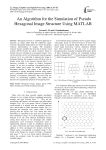
An Algorithm for the Simulation of Pseudo Hexagonal Image Structure Using MATLAB
Статья научная
Hexagonal structure is a different approach to represent an image rather than the traditional square structure. Hexagonal shaped pixels are used in hexagonal structure representation of images. The hexagonal structure closely resembles the structure of human visual systems (HVS) because the photo receptors found in human retina are arranged in a hexagonal manner. Also curved structure can be well represented using hexagonal structure. So if we could able to represent the image in hexagonal domain, the computer vision will be as close to human vision. But in the present scenario there is no hardware available to capture or display hexagonal images. So we have to simulate a hexagonal grid on a regular square pixel image for further processing in hexagonal domain. In this paper, a new method for constricting a pseudo hexagonal structure using square pixel is presented. This method preserves the important property of hexagonal architecture that each pixel has exactly six surrounding neighbors. This method also preserves the equidistance property of hexagonal pixels.
Бесплатно
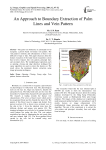
An Approach to Boundary Extraction of Palm Lines and Vein Pattern
Статья научная
The palm vein biometrics is automated tool to recognize a person based on human vein pattern. The vein pattern is intrinsic and subcutaneous so that is very difficult to forge or fake. This paper discusses about the feature extraction of the hand based recognition system that involves features like vein pattern, principal lines and secondary lines. The morphological operations such as opening, closing and edge detection technique like canny algorithm are used to extract the feature set. The result shows the prominent feature extraction using image processing techniques.
Бесплатно
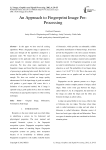
An Approach to Fingerprint Image Pre-Processing
Статья научная
In this paper we have used all existing algorithms. When a fingerprint image is captured it is made pass through all the algorithms arranged in a particular order. We found that if we process a fingerprint in this particular order, the final output is good enough for minutiae detection and feature extraction. We have done many experiments on fingerprint images and found that this particular order of processing is producing better result. But for this we assume that the quality of the captured image is good enough. We have not worked on image quality enhancement. So if the input image is good our method will produce a good output. Off course this is a limitation of our proposed method, but if image is captured using a good quality device, then our method will produce an equal quality output as in other existing techniques.
Бесплатно
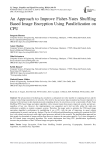
An Approach to Improve Fisher-Yates Shuffling Based Image Encryption Using Parallelization on CPU
Статья научная
The advancement of technology has resulted in a substantial rise in the number of computing devices and the volume of data being transmitted over networks. The need for fast and secure data encryption has become imperative in response to the increase in data transmission and computing devices. In our previous work, we presented a Fisher-Yates Shuffling (FYS) based image encryption algorithm with a timeout feature that ensures improved security and privacy, regardless of key size. However, the implementation was sequential, and it did not fully utilize the multi-core architecture available on modern computer systems. Therefore, this paper seeks to optimize the FYS-based image encryption algorithm’s performance by parallelizing it on a CPU, with the aim of improving its speed without compromising its security and privacy features. The use of Joblib and multithreading are employed to generate the SHA keys, with a quad-core processor with eight logical processors utilized for the research. The parallelization approach has been tested over thousands of images and has been shown to improve the encryption speed by 2 to 5 times compared to the FYS-based image encryption algorithm. The results demonstrate that using CPU parallelization significantly increases the performance of the FYS-based image encryption algorithm.
Бесплатно
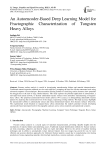
An Autoencoder-Based Deep Learning Model for Fractographic Characterization of Tungsten Heavy Alloys
Статья научная
Fracture surface analysis is crucial in investigating manufacturing failures and material characterization. Traditional manual inspection methods are slow and subjective, prompting the need for efficient automated tools using advanced computer vision techniques. Recent machine learning models for classifying surface fractures show potentials but struggle due to the lack of large, labeled datasets. This study explores the potential application of autoencoders, a self-supervised neural network, to identify unintended fracture surfaces from anomalous manufacturing of tungsten-heavy alloys. The proposed autoencoder-based model achieves 97% accuracy in distinguishing undesirable fracture patterns by analyzing the reconstruction loss of the images, surpassing existing methods. This high accuracy highlights the autoencoder's ability to automatically extract and reduce dimensional features from fracture surfaces effectively. The experimental result obtained on tungsten-heavy alloys demonstrate the model's potential towards developing autoencoder-based automated tools for fractographic analyses across various materials and operational scenarios.
Бесплатно
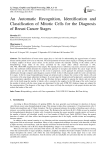
Статья научная
The identification of breast cancer stages plays a vital role for understanding the aggressiveness of cancer disease and the patient survival as an outcome. The main parameter of breast cancer staging is counting the mitotic cells in biopsy samples of breast cancer tissues. In the present scenario the manually counting of the mitotic cells in histopathology image slides of the tissue examined by the expert under clinical microscope is 10X, 20X ,40X ,100X,400X magnification of the sample. The manual process is laborious, inaccurate, erroneous and tedious, hence the traditional method demands the computerized approach to recognize and identify the cancer stages for the expert to come up with robust decision. In this work we proposed a novel approach for automatic recognition and identification through computer aided diagnosis systems (CAD). In this CAD proposed model the work is divided into five stages. In the first stage histopathological image are preprocessed to enhance the contrast of the mitotic cells and non mitotic cells using image adjustment technique. In second stage the foreground and background is segmented using Otsu segmentation algorithm. In the third stage the Bit plane slicing is applied to separate the mitotic and non mitotic cells. In the fourth stage the number of mitotic cells is counted in the samples. In the fifth stage of the work, based on the number of mitotic cells the cancer stages are determined. In this work, ICPR 2012 database images are adopted for the experimentation. The diagnosis of the stage of the cancer will help the oncologist to take proper decision and also reduces the burden of the work.
Бесплатно
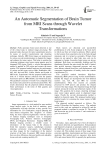
An Automatic Segmentation of Brain Tumor from MRI Scans through Wavelet Transformations
Статья научная
Fully automatic brain tumor detection is one of the critical tasks in medical image processing. The proposed study discusses the tumor segmentation process by means of wavelet transformation and clustering technique. Initially, MRI brain images are preprocessed by various wavelet transformations to sharpen the images and enhance the tumor region. This helps to quicken the clustering technique since tumor region appears good in sharpened CSF region. Finally, a wavelet decomposition method is applied in CSF region and extracts the tumor portion. This proposed method analyzes the performance of various wavelet types such as Haar, Daubechies (db1, db2, db3, db4 and db5), Coiflet, Morlet and Symlet in MRI scans. Experiments with the proposed method were done on 5 volume datasets collected from the popular brain tumor pools are BRATS2012 and whole brain atlas. The quantitative measures of results were compared using the metrics false alarm (FA) and missed alarm (MA). The results demonstrate that the proposed method obtaining better performance in the terms of both quantity and visual appearance.
Бесплатно
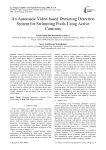
An Automatic Video-based Drowning Detection System for Swimming Pools Using Active Contours
Статья научная
Safety in swimming pools is a crucial issue. In this paper, a real time drowning detection method based on HSV color space analysis is presented which uses prior knowledge of the video sequences to set the best values for the color channels. Our method uses a HSV thresholding mechanism along with Contour detection to detect the region of interest in each frame of video sequences. The presented software can detect drowning person in indoor swimming pools and sends an alarm to the lifeguard rescues if the previously detected person is missing for a specific amount of time. The presented algorithm for this system is tested on several video sequences recorded in swimming pools in real conditions and the results are of high accuracy with a high capability of tracking individuals in real time. According to the evaluation results, the number of false alarms generated by the system is minimal and the maximum alarm delay reported by the system is 2.6 sec which can relatively be reliable compared to the acceptable time for rescue and resuscitation.
Бесплатно
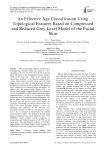
Статья научная
The present paper proposes an innovative technique that classifies human age group in to five categories i.e 0 to 12, 13 to 25, 26 to 45, 46 to 60, and above 60 based on the Topological Texture Features (TTF) of the facial skin. Most of the existing age classification problems in the literature usually derive various facial features on entire image and with large range of gray level values in order to achieve efficient and precise classification and recognition. This leads to lot of complexity in evaluating feature parameters. To address this, the present paper derives TTF’s on Second Order image Compressed and Fuzzy Reduced Grey level (SICFRG) model, which reduces the image dimension from 5 x 5 into 2 x 2 and grey level range without any loss of significant feature information. The present paper assumes that bone structural changes do not occur after the person is fully grown that is the geometric relationships of primary features do not vary. That is the reason secondary features i.e TTF’s are identified and exploited. In the literature few researchers worked on TTF for classification of age, but so far no research is implemented on reduced dimensionality model. The proposed Second order Image Compressed and Fuzzy Reduced Grey level (SICFRG) model reduces overall complexity in recognizing and finding histogram of the TTF on the facial skin. The experimental evidence on FG-NET aging database and Google Images clearly indicates the high classification rate of the proposed method.
Бесплатно

Статья научная
"Cloud computing" refers to internet-based computing on demand and describes an incredibly scalable technology used by working-class and non-working individuals globally. Fault-tolerant task scheduling is an essential tool used by end users and cloud suppliers. Finding the best resource for the specified input task presents a key challenge for fault-tolerant task schedulers. The studies that have already been done have attempted to address each of these complex issues independently. Still, it is tricky to optimize resources and provide fault tolerance at the same time. In this paper, an effective hybrid HBA-MAO and hybrid fault-tolerant mechanism in cloud computing are designed to appropriate task scheduling in VMs without delay and failure. Various tasks submitted by users and virtual machines are taken as input for the proposed approach. Hybrid Honey Badger Optimization Algorithm (HBA) and Mexican Axolotl Optimization (MAO) are used in this proposed for priority based optimal task scheduling. These scheduled tasks are assigned to the VM for execution. A fault-tolerant mechanism is immediately carried out if the tasks are not completed successfully. The hybrid reactive and proactive fault-tolerant mechanism is used in this proposed approach for a high level of fault tolerance. The proposed approach attains better performance, like 70 sec of response time, 13% of resource utilization and 95% success rate. This approach uses resources efficiently by reducing resource consumption, so it is the best choice for fault-tolerant aware task scheduling.
Бесплатно
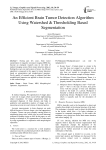
An Efficient Brain Tumor Detection Algorithm Using Watershed & Thresholding Based Segmentation
Статья научная
During past few years, brain tumor segmentation in magnetic resonance imaging (MRI) has become an emergent research area in the field of medical imaging system. Brain tumor detection helps in finding the exact size and location of tumor. An efficient algorithm is proposed in this paper for tumor detection based on segmentation and morphological operators. Firstly quality of scanned image is enhanced and then morphological operators are applied to detect the tumor in the scanned image.
Бесплатно
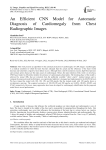
An Efficient CNN Model for Automatic Diagnosis of Cardiomegaly from Chest Radiographic Images
Статья научная
This work presents an algorithm for the automatic detection of cardiomegaly on CXR images. Cardiomegaly is a medical condition in which the heart becomes enlarged than the actual and the efficiency of the heart would decrease and sometimes congestive heart failure occurs. Although there could be numerous reasons, high blood pressure and coronary artery disease are the main causes of cardiomegaly. Hence, the main intention of this work is to develop a CNN based model to efficiently identify the presence of cardiomegaly abnormality. The learning phase of the model is achieved by using CXRs that are extracted from the publically available “chest x-ray14” medical dataset and to compute the proposed model performance, an experimental platform is designed and implemented in the MATLAB tool. We have trained the model with 100, 120, 150, and 200 epochs. But the trained model with 120 epochs shows a revolutionary outcome. The acquired accuracies of 100,120,150 and 200 epochs are 84.69%, 98.00%, 89.09% and 87.64% respectively. However, many approaches have been developed for cardiomegaly identification but the proposed model shows record performance.
Бесплатно
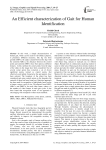
An Efficient Characterization of Gait for Human Identification
Статья научная
In this work, a simple characterization of human gait, which can be used for surveillance purpose, is presented. Different measures, like leg rise from ground (LRFG), the angles created between the legs with the centroid (ABLC), the distances between the control points and centroid (DBCC) have been taken as different features. In this method, the corner points from the edge of the object in the image have been considered. Out of several corner points thus extracted, a set of eleven significant points, termed as control points, that effectively and rightly characterize the gait pattern, have been selected. The boundary of the object has been considered and using control points on the boundary the centroid of those has been found out. Statistical approach has been used for recognition of individuals based on the n feature vectors, each of size 23(collected from LRFG, ABLCs, and DBCCs) for each video frame, where n is the number of video frames in each gait cycles. It has been found that recognition result of our approach is encouraging with compared to other recent methods.
Бесплатно
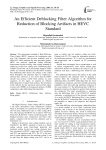
An Efficient Deblocking Filter Algorithm for Reduction of Blocking Artifacts in HEVC Standard
Статья научная
The international standard of High Efficiency Video Coding (HEVC) improves the compression ratio over %50 compared with previous standards such as H264/AVC which maintain the same perceptual quality. HEVC has achieved significant coding efficiency improvement beyond existing video coding standard by employing several new coding tools. Deblocking filter, Adaptive Loop Filter (ALF) and Sample Adaptive Offset (SAO) are currently introduced for the HEVC standard. The deblocking filter detects the artifacts at the coded block boundaries and attenuates them by employing a selected filter. However, it was shown that the HEVC encoder may produce visible block artifacts on some sequences. In this paper, we propose an efficient deblocking filter to reduce block artifacts. The simulation results indicate that the maximum increase Peak signal-to-noise ratio (PSNR) of the proposed method is 0.09db, comparing to other deblocking filter algorithm.
Бесплатно

An Efficient Embedding Technique in Image Steganography Using Lucas Sequence
Статья научная
Image steganography have been observed as one of the useful techniques to prevent unintended users to understand what information has been communicated over the network. Many crucial methods of image steganography include Discrete Cosine Transformation (DCT) based approaches. In this paper an efficient algorithm in image steganography is proposed extending DCT based approaches and incorporating number theory. The existing DCT algorithm is modified to increase randomness in the embedding technique with the help of Lucas sequence specifically. The effectiveness of the proposed method has been evaluated by computing Mean Square Error (MSE) and Peak Signal to Noise Ratio (PSNR). Results show that the proposed method has higher embedding capacity and increases a significant level of security by using Lucas sequence in addition to the advantages provided by existing DCT algorithm.
Бесплатно
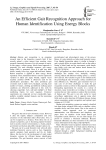
An Efficient Gait Recognition Approach for Human Identification Using Energy Blocks
Статья научная
Human gait recognition is an emerging research topic in the biometrics research field. It has recently gained a wider interest from machine vision research community because of its rich amount of merits. In this paper, a robust energy blocks based approach is proposed. For each silhouette sequence, gait energy image (GEI) is generated. Then it is split into three blocks, namely lower legs, upper-half and head. Further, Radon transform is applied to three energy blocks separately. Then, standard deviation is used to capture the variation in radial axis angle. Finally, support vector machine classifier (SVM) is effectively used for the classification procedures. The more prominent gait covariates such as multi views, backpack, carrying, least number of frames, clothing and different walking speed conditions are effectively addressed in this work by choosing sequential, even, odd and multiple’s of three numbering frames for each sequence. Extensive experiments are conducted on four considerably large, publicly available standard datasets and the promising results are obtained.
Бесплатно
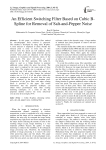
An Efficient Switching Filter Based on Cubic B-Spline for Removal of Salt-and-Pepper Noise
Статья научная
In this paper, an efficient filter method for salt-and-pepper noise removal is proposed. This method is developed by using cubic B-spline. A noise detector is employed to check whether the selected pixel is noisy or noise free. In this method, noise free pixels are left unaltered. Since not every pixel is filtered, undue distortion can be avoided. Noise pixels are subjected to the filtering operation to reconstruct the intensity values of the noisy pixels. The noise free pixels are only considered in the filter operation. The cubic B-spline is used as a fitting function to generate additional values within the noise free pixels. The noisy pixel is replaced by the mean value of these pixel values. The window size is selected as 3 X 3 in the first step. If all pixels within the window are considered to be noise, then change the selected window size to 5 X 5. If all the pixels within this window are considered to be noise, then the noisy pixel is replaced by the previous resultant pixel. Comparison of the given filter with other existing filters is provided in this paper. The results demonstrate that the proposed technique can obtain better performances than other existing denoising techniques. As a result of this, the proposed method removes the noise effectively even at noise level as high as 97%.
Бесплатно
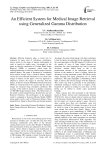
An Efficient System for Medical Image Retrieval using Generalized Gamma Distribution
Статья научная
Efficient diagnosis plays a crucial role for treatment. In many cases of criticalness, radiologists, doctors prefer to the usage of internet technologies in order to search for similar cases. Accordingly in this paper an effective mechanism of Content Based Image Retrieval (CBIR) is presented, which helps the radiologists/doctors in retrieving similar images from the medical dataset. The paper is presented by considering brain medical images from a medical dataset. Feature vectors are to be extracted efficiently so as to retrieve the images of interest. In this paper a two-way approach is adopted to retrieve the images of relevance from the dataset. In the first step the Probability Density Functions (PDF) are extracted and in the second step the relevant images are extracted using correlation coefficient. The accuracy of the model is tested on a database consisting of 1000 MR images related to brain. The effectiveness of the model is tested using Precision, Recall, Error rate and Retrieval efficiency. The performance of the proposed model is compared to Gaussian Mixture Model (GMM) using quality metrics such as Maximum distance, Mean Squared Error, Signal to Noise Ratio and Jaccard quotient.
Бесплатно
Статья научная
Video steganography is used to conserve the confidential information in various security applications. To give advance protection to the secrete message, pixels locations are optimized using nature inspired algorithm. The input video is separated into a sequence of still image frames then key frames are extracted. The proposed Required Pixel Density (RPD) value calculation and feature extraction are carried out on the extracted frames to perform the frame classification. The frame classification is done using proposed Fractional Water-Earth Worm optimization algorithm based Deep Convolutional Neural Network (FrWEWO-Deep CNN) in order to classify the frames as high, low and medium quality. Thus pixel location prediction is carried out using trained Deep CNN then secret image is hide within high quality frame with Wavelet Transform (WT) and Inverse WT (IWT). Peak Signal to Noise Ratio (PSNR) and Correlation Coefficient (CC) are performance evaluation parameters. For efficient video steganography better imperceptibility and robustness are required. Imperceptibility is a scale of PSNR value showing similarity between original and stego video frames. The robustness of video steganography is measured by CC between embedded and extracted secret images. The proposed algorithm gives enhanced performance is compared with previous state of art such as WEWO-Deep RNN. The PSNR value is progressed from 41.8492 to 46.5728 dB and CC value improved from 0.9660 to 0.9847.
Бесплатно

